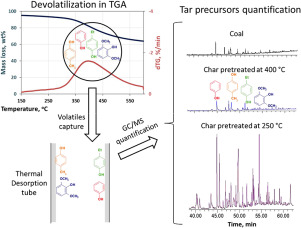当前位置:
X-MOL 学术
›
Fuel Process. Technol.
›
论文详情
Our official English website, www.x-mol.net, welcomes your
feedback! (Note: you will need to create a separate account there.)
Lignocellulose thermal pretreatment and its effect on fuel properties and composition of the condensable products (tar precursors) from char devolatilization for coal substitution in gasification application
Fuel Processing Technology ( IF 7.2 ) Pub Date : 2018-10-01 , DOI: 10.1016/j.fuproc.2018.07.015 Frank Nsaful , François-Xavier Collard , Johann F. Görgens
Fuel Processing Technology ( IF 7.2 ) Pub Date : 2018-10-01 , DOI: 10.1016/j.fuproc.2018.07.015 Frank Nsaful , François-Xavier Collard , Johann F. Görgens

|
Abstract To establish the potential of thermally pretreated biomass as fuel for coal replacement in applications such as gasification, the fuel properties (higher heating value, elemental and proximate analyses) and the composition of char devolatilization products were analyzed and compared to those of sub-bituminous coal. Samples of pine, bamboo, corn cob and corn stover were pretreated at 250, 300, 350 and 400 °C with a hold time of 30 min. The devolatilization experiments were done in a Thermogravimetric analyzer, while captured volatiles were analyzed by thermal desorption/gas chromatography–mass spectrometry. The results showed that an increase in pretreatment temperature consistently decreased the oxygen and volatile matter contents of the char, while its fixed carbon content and the higher heating values increased, with a more drastic evolution from 300 °C onwards. Analysis of the char devolatilization products confirmed a major modification of the polysaccharides structure, as only traces of depolymerisation products were observed following pretreatment at 350 °C. Devolatilization of chars pretreated at 350 and 400 °C resulted in the evolution of the tar precursors, especially the phenolics, at similar and lower amounts, respectively, in comparison to coal devolatilization. Overall, a pretreatment temperature of at least 350 °C would be recommended for sub-bituminous coal substitution in gasification, while 400 °C could be considered for biomass species with high lignin content.
中文翻译:

木质纤维素热预处理及其对气化应用中煤替代的焦炭脱挥可冷凝产物(焦油前体)的燃料性质和组成的影响
摘要 为了确定热预处理生物质在气化等应用中作为煤替代燃料的潜力,对燃料特性(较高的热值、元素和近似分析)和焦炭脱挥发产物的组成进行了分析,并与亚烟煤的相比较。煤炭。松树、竹子、玉米芯和玉米秸秆样品在 250、300、350 和 400 °C 下预处理,保持时间为 30 分钟。脱挥发分实验在热重分析仪中进行,而捕获的挥发物则通过热解吸/气相色谱-质谱法进行分析。结果表明,随着预处理温度的升高,炭的氧含量和挥发分含量不断降低,而其固定碳含量和较高的热值则增加,从 300 °C 开始,有更剧烈的演变。对炭脱挥发分产物的分析证实了多糖结构的重大改变,因为在 350 °C 预处理后仅观察到微量的解聚产物。与煤的脱挥发分相比,在 350 和 400 °C 下预处理的炭的脱挥发分导致焦油前体,特别是酚类物质的析出,分别以相似和较低的量释放。总体而言,对于气化中的亚烟煤替代,建议至少 350 °C 的预处理温度,而对于木质素含量高的生物质物种,可以考虑 400 °C。因为在 350 °C 预处理后仅观察到微量的解聚产物。与煤的脱挥发分相比,在 350 和 400 °C 下预处理的炭的脱挥发分导致焦油前体,特别是酚类物质的析出,分别以相似和较低的量释放。总体而言,对于气化中的亚烟煤替代,建议至少 350 °C 的预处理温度,而对于木质素含量高的生物质物种,可以考虑 400 °C。因为在 350 °C 预处理后仅观察到微量的解聚产物。与煤的脱挥发分相比,在 350 和 400 °C 下预处理的炭的脱挥发分导致焦油前体,尤其是酚类物质的析出量分别相似和较低。总体而言,对于气化中的亚烟煤替代,建议至少 350 °C 的预处理温度,而对于木质素含量高的生物质物种,可以考虑 400 °C。
更新日期:2018-10-01
中文翻译:

木质纤维素热预处理及其对气化应用中煤替代的焦炭脱挥可冷凝产物(焦油前体)的燃料性质和组成的影响
摘要 为了确定热预处理生物质在气化等应用中作为煤替代燃料的潜力,对燃料特性(较高的热值、元素和近似分析)和焦炭脱挥发产物的组成进行了分析,并与亚烟煤的相比较。煤炭。松树、竹子、玉米芯和玉米秸秆样品在 250、300、350 和 400 °C 下预处理,保持时间为 30 分钟。脱挥发分实验在热重分析仪中进行,而捕获的挥发物则通过热解吸/气相色谱-质谱法进行分析。结果表明,随着预处理温度的升高,炭的氧含量和挥发分含量不断降低,而其固定碳含量和较高的热值则增加,从 300 °C 开始,有更剧烈的演变。对炭脱挥发分产物的分析证实了多糖结构的重大改变,因为在 350 °C 预处理后仅观察到微量的解聚产物。与煤的脱挥发分相比,在 350 和 400 °C 下预处理的炭的脱挥发分导致焦油前体,特别是酚类物质的析出,分别以相似和较低的量释放。总体而言,对于气化中的亚烟煤替代,建议至少 350 °C 的预处理温度,而对于木质素含量高的生物质物种,可以考虑 400 °C。因为在 350 °C 预处理后仅观察到微量的解聚产物。与煤的脱挥发分相比,在 350 和 400 °C 下预处理的炭的脱挥发分导致焦油前体,特别是酚类物质的析出,分别以相似和较低的量释放。总体而言,对于气化中的亚烟煤替代,建议至少 350 °C 的预处理温度,而对于木质素含量高的生物质物种,可以考虑 400 °C。因为在 350 °C 预处理后仅观察到微量的解聚产物。与煤的脱挥发分相比,在 350 和 400 °C 下预处理的炭的脱挥发分导致焦油前体,尤其是酚类物质的析出量分别相似和较低。总体而言,对于气化中的亚烟煤替代,建议至少 350 °C 的预处理温度,而对于木质素含量高的生物质物种,可以考虑 400 °C。











































 京公网安备 11010802027423号
京公网安备 11010802027423号